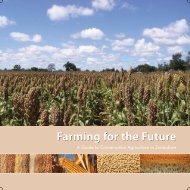Restoring the Soil - Canadian Foodgrains Bank
Restoring the Soil - Canadian Foodgrains Bank
Restoring the Soil - Canadian Foodgrains Bank
You also want an ePaper? Increase the reach of your titles
YUMPU automatically turns print PDFs into web optimized ePapers that Google loves.
Decision Tree Guide35Decision Tree GuideEach of <strong>the</strong> points below refers to a numbered box in <strong>the</strong> decision tree. Each pointprovides additional information on <strong>the</strong> decision tree boxes and will assist in selectingoptions as one moves through <strong>the</strong> decision tree.1. Farmers’ priorities. If farmers do not include soil fertility or <strong>the</strong> need for fertilizersas one of <strong>the</strong>ir two or three most important problems, and don’t seem toshow much interest in working on soil fertility, go to #2. If <strong>the</strong>y do identify soilinfertility as a major problem and show a strong interest in trying to solve <strong>the</strong>problem, go to #4.2. The importance of gm/ccs. Seriously consider <strong>the</strong> possibility of not working insoil fertility. If <strong>the</strong> decision is not to work in soil fertility, go to #3. If you stillbelieve strongly that soil fertility is a major problem in <strong>the</strong> area and success intackling it is still definitely possible, go to #4.3. The end. This is <strong>the</strong> end of <strong>the</strong> program’s work in gm/ccs. Maybe something willchange (for instance, people’s soils become poorer, so <strong>the</strong>y will have more motivationto improve <strong>the</strong>m) that will make gm/ccs more attractive or easier to managein <strong>the</strong> future, but for now, gm/ccs will not be part of <strong>the</strong> program’s agenda.4. A successful system nearby? Is <strong>the</strong>re a successful gm/cc system near <strong>the</strong> projectlocation or in an area of roughly similar farming systems and ecological environment?Or do <strong>the</strong> farmers know of such a system, and are <strong>the</strong>y interested in it?Are more smallholder farmers adopting this gm/cc system, or are <strong>the</strong>y graduallyabandoning it? Are <strong>the</strong>y adopting it in <strong>the</strong> absence of any artificial subsidies orany program that is promoting it? If <strong>the</strong> answer is yes to most of <strong>the</strong>se questions,go to #5. If <strong>the</strong>re is no such system, go to #10.If <strong>the</strong>re is such a system, but you cannot answer yes to <strong>the</strong> questions, interview<strong>the</strong> farmers that are using it, being careful not to just take <strong>the</strong>ir answers at facevalue. Analyze <strong>the</strong> system’s economics and its pros and cons, both according to<strong>the</strong> farmers and according to your own analysis. If <strong>the</strong> system does not seem toprovide more benefits than costs, go to #10. If it does, go to #5.5. Field trials. Organize at least three or four trials of <strong>the</strong> technologies in question.Preferably, trials can be done on <strong>the</strong> land of <strong>the</strong> best farmer leaders, or of thosefarmers who will do <strong>the</strong> best job of managing <strong>the</strong> experiments and whose farms,if possible, are accessible. If <strong>the</strong>re is not a strong relationship with <strong>the</strong> farmers, or<strong>the</strong> farmers may not properly manage <strong>the</strong> experiments, conduct a trial on a smallplot of rented or borrowed land.Keep very close records of <strong>the</strong> costs and benefits as compared to traditional systems,being especially careful to include all labor costs. Far too often those of us
















